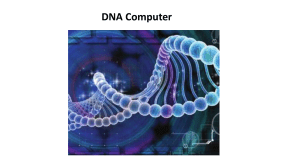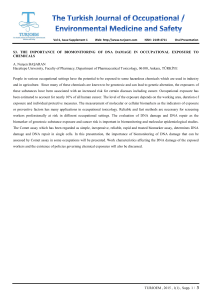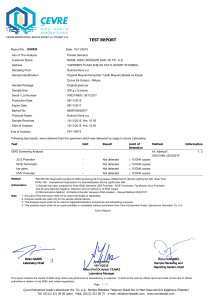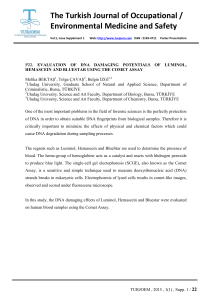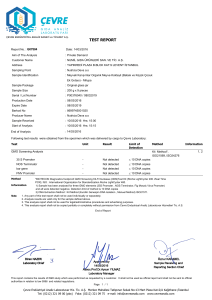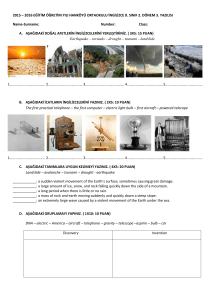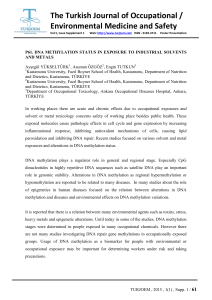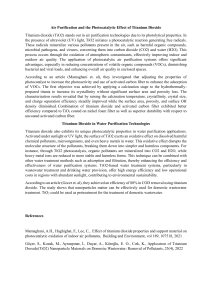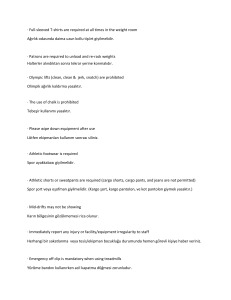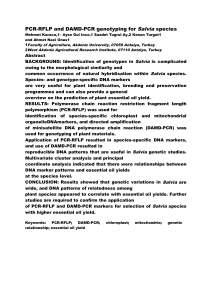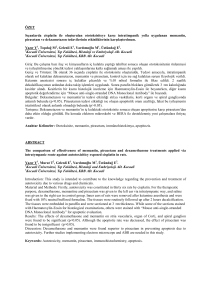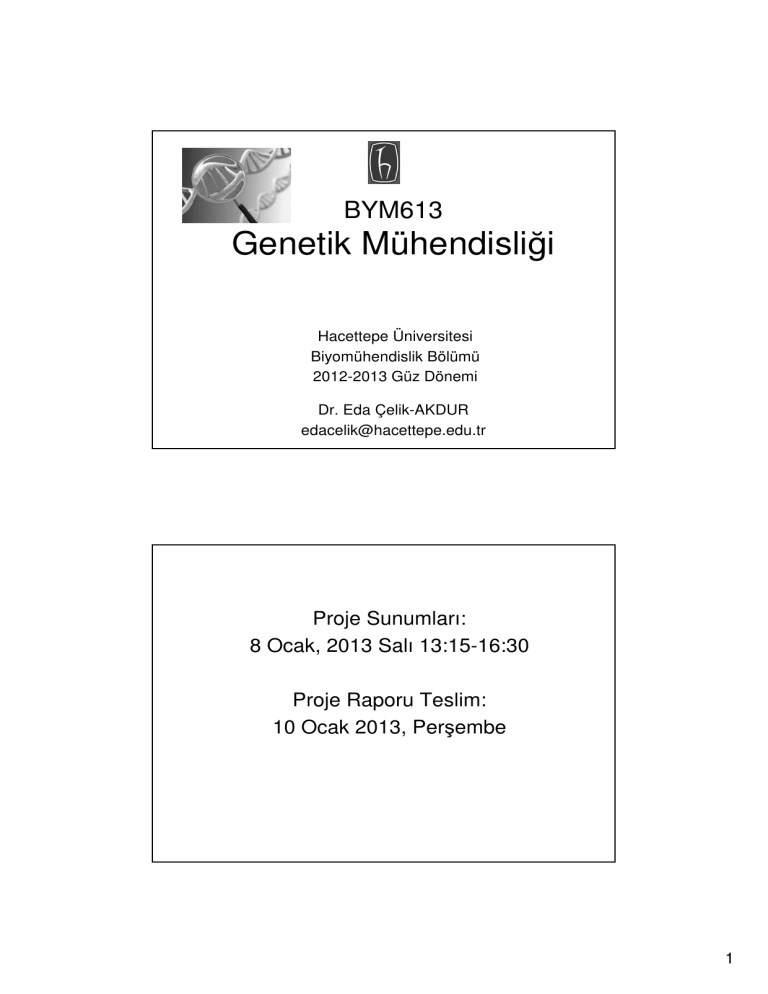
BYM613
Genetik Mühendisliği
Hacettepe Üniversitesi
Biyomühendislik Bölümü
2012-2013 Güz Dönemi
Dr. Eda Çelik-AKDUR
[email protected]
Proje Sunumları:
8 Ocak, 2013 Salı 13:15-16:30
Proje Raporu Teslim:
10 Ocak 2013, Perşembe
1
Proje’de değerlendirilmesi beklenen konular :
•Ürününüzü, ürünün yapısını (örneğin PTM var mı), E.C. numarasını, ekonomik
değerini, kullanım alanlarını açıklayınız. (BRENDA web sitesinden faydalabilirsiniz.)
•Rekombinant olarak üreteceğiniz mikroorganizmayı ve özelliklerini, neden bu
organizmayı seçtiğinizi tartışınız.
•Proteini kodlayan geni hangi organizmadan nasıl elde edeceğinizi veya hangi gen
bankasından satın alacağınızı belirtiniz. Gen bankası numarasını belirtiniz (NCBI web
sitesinden bulabilirsiniz.)
•Üretim için klonlayacağınız vektörü, türünü, nereden satın alacağınızı (örneğin
Invitrogen,
ATCC,
vs.),
neden
bu
vektörü
seçtiğinizi
açıklayınız.
•Proteinin nereden (Periplazmadan, sitoplazmadan veya hücre dışından)
saflaştırılacağını ve önerdiğiniz saflaştırma basamaklarını 1 paragrafta açıklayanız
(Ör: önce hücreler çöktürülecek, sonra hücre atılacak veya hücre içi ise parçalanacak,
daha sonra örneğin affinite kromatografisi ile saflaştırılacak, vs.).
Vektörün tasarım aşamalarını detaylandırınız.
• Örneğin hangi promotörü içeriyor ve bu güçlü mü, yoksa zayıf bir promotör
müdür?
• Genin kaynağını biliyorsunuz, peki nasıl çoğaltacaksınız? (PCR ile mi, yoksa
hücreleri dolayısıyla plazmidi çoğaltıp, plazmidi ekstrakte edip, RE ile geni
kesmek suretiyle mi?) PCR ise primerlerinizi tasarlayınız.
• Hangi RE’lerini kullanarak vektör ile birleştireceksiniz. Bu enzimlerin çalışma
koşulları nedir? (çoğu enzimin optimum çalışma sıcaklığı 37°C’dir ancak
kontrol edilmelidir.)
• Proteini saflaştırmak veya ucuz antikorlar ile görüntüleyebilmek için (Western
Blot ile), vektörünüze ilgili peptidi kodlayan bir DNA dizini ekleyecek misiniz?
Bu dizini, PCR ile ancak ekleyebilirsiniz, dolayısıyla PCR için primerlerinizi
tasarlarken bunu da göz önüne almalısınız.
• Vektörün içine klonlayacağınız kasetin DNA dizinini, FASTA formatında ve
ilgili bölgeleri adlandırılmış biçimde raporunuza ekleyiniz. (kaset: geni, RE
bölgelerini, saflaştırma/tanıma peptidlerini kodlayan DNA dizinini içerir. Ayrıca,
vektörde bulunmuyorsa, başlama ve dur kodonlarını da içermelidir.)
2
“Proteomics” & “Metabolomics”
•Proteomics-
is the study of the proteome, which
corresponds to all of the proteins expressed in a
given tissue under a particular set of conditions
•Metabolomics-is
the study of metabolites (e.g.,
calcium, cholesterol, glucose) present in a given
tissue under a particular set of conditions
* Others now such as Bioinformatics and Glycomics
3
“Genomics”
a branch of biotechnology concerned with
applying the techniques of genetics and
molecular biology to the genetic mapping
and DNA sequencing of sets of genes or
the complete genomes of selected
organisms, with organizing the results in
databases, and with applications of the
data (as in medicine or biology)
Anticipated Benefits of
Genome Research
Molecular Medicine
• improve diagnosis of disease
• detect genetic predispositions to disease
• create drugs based on molecular information
• use gene therapy and control systems as drugs
• design “custom drugs” (pharmacogenomics) based on individual genetic profiles
Microbial Genomics
• rapidly detect and treat pathogens (disease-causing microbes) in clinical practice
• develop new energy sources (biofuels)
• monitor environments to detect pollutants
• protect citizenry from biological and chemical warfare
• clean up toxic waste safely and efficiently
U.S. Department of Energy Genome Programs, Genomics and Its Impact on Science and Society, 2003
4
Anticipated Benefits of
Genome Research-cont.
Risk Assessment
• evaluate the health risks faced by individuals who may be exposed to radiation
(including low levels in industrial areas) and to cancer-causing chemicals and toxins
Bioarchaeology, Anthropology, Evolution, and Human Migration
• study evolution through germline mutations in lineages
• study migration of different population groups based on maternal inheritance
• study mutations on the Y chromosome to trace lineage and migration of males
• compare breakpoints in the evolution of mutations with ages of populations and
historical events
U.S. Department of Energy Genome Programs, Genomics and Its Impact on Science and Society, 2003
Anticipated Benefits of
Genome Research-cont.
DNA Identification (Forensics)
• identify potential suspects whose DNA may match evidence left at crime scenes
• exonerate persons wrongly accused of crimes
• identify crime and catastrophe victims
• establish paternity and other family relationships
• identify endangered and protected species as an aid to wildlife officials (could be
used for prosecuting poachers)
• detect bacteria and other organisms that may pollute air, water, soil, and food
• match organ donors with recipients in transplant programs
• determine pedigree for seed or livestock breeds
• authenticate consumables such as caviar and wine
U.S. Department of Energy Genome Programs, Genomics and Its Impact on Science and Society, 2003
5
Anticipated Benefits of
Genome Research-cont.
Agriculture, Livestock Breeding, and Bioprocessing
• grow disease-, insect-, and drought-resistant crops
• breed healthier, more productive, disease-resistant farm animals
• grow more nutritious produce
• develop biopesticides
• incorporate edible vaccines incorporated into food products
• develop new environmental cleanup uses for plants like tobacco
U.S. Department of Energy Genome Programs, Genomics and Its Impact on Science and Society, 2003
Medicine and the New
Genetics
Gene Testing Pharmacogenomics Gene
Therapy
Anticipated Benefits:
• improved diagnosis of disease
• earlier detection of genetic predispositions to disease
• rational drug design
• gene therapy and control systems for drugs
• personalized, custom drugs
U.S. Department of Energy Genome Programs, Genomics and Its Impact on Science and Society, 2003
6
Protein techniques
Protein
Identification
Protein Expression
Protein Purification
Protein-Protein interactions
Application
in literature
7
Methods Used for Protein Quantity Determination
Biuret
Test
Folin-Ciocalteu ( Lowry ) Assay
Bicinchoninic Acid ( BCA ) Assay
Dye-Binding ( Bradford ) Assay
Ultraviolet Absorbance
Ultraviolet Absorbance
Estimation Procedure
1.
Zero spectrophotometer to water (or buffer)
2.
Take the absorbance at 280 nm in a quartz cuvette
3.
Change wavelength to 260 nm and zero with water (or buffer)
4.
Take absorption at 260 nm in a quartz cuvette
5.
Use the following equation to estimate the protein concentration
[Protein] (mg/mL) = 1.55*A280 – 0.76*A260
8
Protein Identification
Sequencing (Edman degradation)
Centrifugation (cellular location)
1D/2D Gel Electrophoresis
ELISA “Enzyme-linked immunosorbent assay”
Mass spectrometry
Determine approx the first 20 AA
Break sample into peptides
Molecular mass is determined using mass-to-charge (m/z) ratios
of ions
AA sequence can be determined
Protein microarray
NMR (Nuclear Magnetic Resonance)
X-Ray Cristallography
What You Can Learn from Amino Acid Sequence
1. Molecular weight of the polypeptide chain
2. Charge versus pH; Isoelectric point
3. Hydrophobicity & membrane spanning regions
4. Potential modification sites
5. Conserved motifs that suggest cofactor affinity
What You Can’t Learn from Amino Acid Sequence
1.Function
2. 3-Dimensional structure; Shape
3. Multi-subunit features
4. Ammonium sulfate precipitation properties
5. Surface features (hydrophobic patches, charge
distribution, antigenic sites)
9
Differential centrifugation
Gel electrophoresis
Denaturing – SDS-PAGE
Non-denaturing
SDS gives uniform neg. charge
Separates proteins by size/mass
Separates based on charge and size/conformation
Often combined with Western blotting (using
antibodies specific for proteins of interest)
10
SDS-PAGE
1
2
3
4
5
6
2D gel electrophoresis
1st
Separation based on pI
isoelectric focusing of zwitterions
2nd
dimension
dimension
Normal SDS-PAGE
* pI = pH where protein has zero net charge
Typical range of pI = 4-9
11
Estimating the charge of a protein
At pH 3 the
protein will
be +ve
[H+]
pH ~3
pI ~5
[OH-]
Protein becomes
increasingly +ve
[H+]
[OH-]
Protein becomes increasingly -ve
2D-GE
12
Western Blotting
Mass spectrometry
IDs
based on mass-to-charge (m/z) ratio
Samples are broken down and analyzed
Proteins -> peptides
Able
to determine seq of peptides
Database search to ID protein
13
Mass spectrometry
14
Mass spec combos
LC/MS
MALDI-TOF MS
Liquid chromotography to separate peptides
Matrix-assisted laser desorption-time of flight
Samples are ionized and “flight time” through an
electrified tube is measured
Tandem MS
Multiple MS measurements on a single sample
Identifies peptide sequence
ELISA
Enzyme-linked immunosorbent assay
15
Protein
Microarray
Kullanım alanları
•proteinlerin varlığının ve
miktarının belirlenmesi
•protein-protein etkileşimi
•protein-nükleik asit
etkileşimi
•enzimlerin
substratlarının
bulunması
Protein Expression and Purification
Why?
Obtain pure (clean) protein
"Don't waste clean thinking on dirty enzymes“
- Arthur Kornberg
Powerful
experimental tool
Simplifies the system in which you are asking
a question
Confirmation of a hypothesis that is
developed in a more complex system
16
Protein Expression
Why over-express the protein?
Make large quantities to facilitate
purification/study
Analyze biochemical properties
Perform structural analyses
Crystallization
NMR
Identify protein interactions
Make Antibodies
Expression systems
E. coli
Yeast
For bacterial or eukaryotic proteins
Large amounts of protein
Insect cells
Prokaryotic expression workhorse
Post-translational modifications
In-vitro systems
wheat germ, rabbit reticulocyte
17
Purification strategies
Exploiting protein chemistry
Size/Mass
Charge
Hydrophobicity
Antibody affinity
Protein Tags
Often used in combination
Separation processes that can be used
to fractionate proteins
Separation Process
Basis of Separation
Precipitation
ammonium sulfate
polyethyleneimine (PEI)
isoelectric
solubility
charge, size
solubility, pI
Chromatography
gel filtration (SEC)
size, shape
ion exchange (IEX)
charge, charge distribution
hydrophobic interaction(HIC) hydrophobicity
DNA affinity
DNA binding site
immunoaffinity (IAC)
specific epitope
chromatofocusing
pI
Electrophoresis
gel electrophoresis (PAGE) charge, size, shape
isoelectric focusing (IEF)
pI
Centrifugation
Ultrafiltration
sucrose gradient
size shape, density
ultrafiltration (UF)
size, shape
18
Size Exclusion Chromatography
Separation based on size of protein
Ion exchange
19
HPLC
High performance (pressure) liquid
chromatography
Sample is passed over column of varying
hydrophobic nature- more hydrophobic particles
bind tighter and elutes later.
Eluate is analyzed by a detector
UV, refractive index, fluorescence
Can be combined with mass spec (LC/MS)
HPLC
20
Affinity/Ab columns
Purify
tagged proteins
Interaction between two molecules
Solid phase- immobilized on column
Mobile phase- binds while passing over
column
Buffer
conditions regulate binding &
dissociation
pH, ionic strength, competing
Ab affinity column
21
Tagging the protein
Clone
gene in frame with a unique
protein sequence or “tag”
Advantages
Purification
• Use tag to selectively remove protein from a
complex sample
Protein visualization/tracking
• Fluorescent protein tags, labeled antibodies
Protein Tags
His
small
6 HIS residues bind to nickel or cobalt
columns
GST
Binds to glutathione resin/beads
S-Tag,
C-myc, HA, flag
Antibody affinity columns
22
Protein Tags
6xHistidine binds metal chelating resinCu2+, Ni2+, Co 2+
Commercially available protein purification kits
•GST•Bind™ Purification Kits
•His•Bind® Purification Kits
•Magnetight™ Oligo d(T) Beads
•MagPrep® Streptavidin Beads
•Protein A and Protein G Plus Agaroses
•S•Tag™ Purification Kits
•Streptavidin Agarose
•T7•Tag™ Affinity Purification Kit
•ProteoSpin™ CBED (Concentration, Buffer Exchange and Desalting) Maxi Kit
— Effectively desalts and concentrates up to 8 mg of protein with an efficient, easyto-use protocol.(Norgen Biotek Corporation)
•ProteoSpin™ Detergent Clean-up Micro Kit — Provides a fast and effective
procedure to remove detergents including SDS, Triton® X-100, CHAPS, NP-40 and
Tween 20.
(http://www.emdbiosciences.com)
23
İnce Tabaka Kromatografisi (TLC)
•Proteinlerin çözünme yeteneklerine göre ayrışım yapılır.
•Katı bir yüzeye (selüloz) emdirilen
örnek çözücü yüzey içine
yerleştirilir. Çözücü solüsyonun yüzeyde ilerlemesiyle, örnekteki
proteinler çözünme yeteneklerine göre ayrılırlar.
What can you do with purified proteins?
Biochemical and functional characterization
Structural analyses informs function
DNA binding, enzyme activity, stability, etc.,
NMR, crystallography, circular dichroism
Study protein-protein or protein-DNA
interactions
Develop antibodies, therapeutics
24

